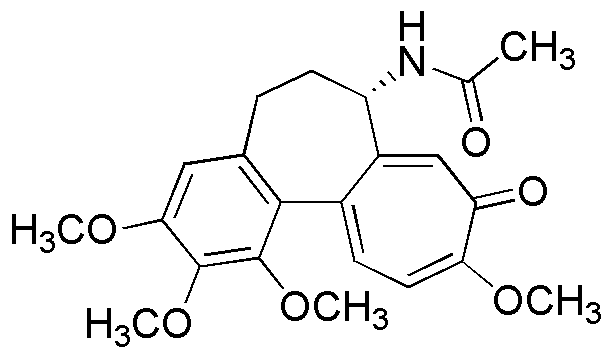(-)-Colchicine is widely utilized in research focused on:
- Gout Treatment: It is a well-known medication for managing gout attacks by reducing inflammation and pain associated with the condition.
- Cell Biology: Researchers use colchicine to study cell division, as it disrupts the formation of microtubules, allowing scientists to investigate mitosis and cellular processes.
- Genetic Research: In plant breeding, colchicine is applied to induce polyploidy, which can lead to the development of new plant varieties with desirable traits.
- Cancer Research: Its ability to inhibit cell division makes it a valuable tool in cancer research, helping to understand tumor growth and the effects of chemotherapy.
- Inflammatory Diseases: Colchicine is also being explored for its potential benefits in treating other inflammatory conditions, such as familial Mediterranean fever, showcasing its versatility in therapeutic applications.
General Information
Properties
Safety and Regulations
Applications
(-)-Colchicine is widely utilized in research focused on:
- Gout Treatment: It is a well-known medication for managing gout attacks by reducing inflammation and pain associated with the condition.
- Cell Biology: Researchers use colchicine to study cell division, as it disrupts the formation of microtubules, allowing scientists to investigate mitosis and cellular processes.
- Genetic Research: In plant breeding, colchicine is applied to induce polyploidy, which can lead to the development of new plant varieties with desirable traits.
- Cancer Research: Its ability to inhibit cell division makes it a valuable tool in cancer research, helping to understand tumor growth and the effects of chemotherapy.
- Inflammatory Diseases: Colchicine is also being explored for its potential benefits in treating other inflammatory conditions, such as familial Mediterranean fever, showcasing its versatility in therapeutic applications.
Documents
Safety Data Sheets (SDS)
The SDS provides comprehensive safety information on handling, storage, and disposal of the product.
Product Specification (PS)
The PS provides a comprehensive breakdown of the product’s properties, including chemical composition, physical state, purity, and storage requirements. It also details acceptable quality ranges and the product's intended applications.
Certificates of Analysis (COA)
Search for Certificates of Analysis (COA) by entering the products Lot Number. Lot and Batch Numbers can be found on a product’s label following the words ‘Lot’ or ‘Batch’.
*Catalog Number
*Lot Number
Certificates Of Origin (COO)
This COO confirms the country where the product was manufactured, and also details the materials and components used in it and whether it is derived from natural, synthetic, or other specific sources. This certificate may be required for customs, trade, and regulatory compliance.
*Catalog Number
*Lot Number
Safety Data Sheets (SDS)
The SDS provides comprehensive safety information on handling, storage, and disposal of the product.
DownloadProduct Specification (PS)
The PS provides a comprehensive breakdown of the product’s properties, including chemical composition, physical state, purity, and storage requirements. It also details acceptable quality ranges and the product's intended applications.
DownloadCertificates of Analysis (COA)
Search for Certificates of Analysis (COA) by entering the products Lot Number. Lot and Batch Numbers can be found on a product’s label following the words ‘Lot’ or ‘Batch’.
*Catalog Number
*Lot Number
Certificates Of Origin (COO)
This COO confirms the country where the product was manufactured, and also details the materials and components used in it and whether it is derived from natural, synthetic, or other specific sources. This certificate may be required for customs, trade, and regulatory compliance.


